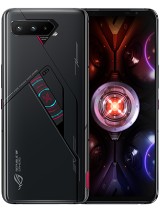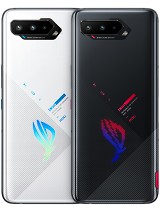I thought phone innovation was dead. - ASUS ROG Phone 5 Review By Linus Tech Tips
- That gesture stuff is really cool. I honestly thought that smartphone innovation was dead for years now. It's never even occurred to me that I could get excited about a phone again. And then, I saw the Asus ROG Phone 5, and in an instant, I knew that I couldn't just make a quick short circuit video about this thing. Yeah, it's really heavy. And a few of its party tricks will get old pretty quick, but there is so much raw innovation in here that I just need to tell you more about it.
Just like I need to tell you more about our sponsors, Seasonic. Never skimp on getting a quality power supply for your next build. Check out, Seasonic to find their award-winning power supplies and try out their wattage calculator to see which one will suit your needs at the link below. (upbeat music) Asus really knows how to package a phone in a way that's unique and yet not obnoxious. The Ultimate edition ROG Phone 5 comes in a gameresque, squared off triangular prism that folds out to reveal compartments for both the phone itself and its accessories, including the optional AeroActive Cooler 5 that clips onto the phone and gets its power from pogo pins hidden under the rubber gasket on the side.
Note that I said optional, the chassis is solid aluminum with a copper vapor chamber cooler inside, so there's plenty of thermal mass to soak up heat, meaning that a fan might not be necessary for everyone. Add in the twin 3,000 mAh batteries though, and it means you've got one husky boy. The exterior is reassuringly gamer, albeit with a much flatter back panel than previous generation ROG phones. All we've got back here are the camera bump, which is barely even a bump by modern standards, and wait, is that a display? Yes, yes it is. There's a black and white OLED display, that's one of the benefits of the Ultimate edition, while the regular ROG Phone 5 gets an RGB logo instead.
As for Pro users, you guys actually get a full color OLED panel because Asus do be extra like that. And every skew gets an extra USB type C port on the side for landscape docking, HDMI output if you wanted to use your phone as a controller while playing on the big screen or for charging. Across the whole range, top shelf specs are consistent. The Ultimate comes with a whopping 512 gigs of UFS 3.1 storage and 18 gigabytes of LPDDR5 memory, while the rest of the range boasts equally performant, but smaller configs. And naturally, it's running the latest Snapdragon 888 SOC with all of the good that comes with that.
That means better performance across the board compared to last gen, built-in 5G and Wi-Fi 6E, which should help improve throughput in dense areas like classrooms and apartments, along with massive improvements to image processing and AI performance. As for the CPU and GPU performance bump, it's relatively incremental, unless of course you're coming from a device that's two years old or more. But, support for variable rate shading, which lowers image quality in your peripheral vision, could result in some significant perceived gains in games. It also has some non Snapdragon specific bells and whistles, including dual SIM support, quad microphones, and a reconfigured Wi-Fi antenna array to improve performance in landscape mode. Also, you headphone jack diehards are gonna love this.
It has a seriously chatted out DAC and Amp configuration for listening to music on the go, with wired headphones. How does the water bottle from lttstore. com figure in here? That's okay, it doesn't matter, lttstore. com. Brandon described the rear shooter as solid, not class-leading, but solid.
And in most of our shots, Asus ROG Phone 5 easily outdoes the Pixel 5 in all areas but one, sharpness. There's a very aggressive smoothing algorithm being applied here that sometimes wipes out distant texts and fine details, and it seems like a Asus is compensating with a stronger sharpening filter than we'd like to see. Auto white balance and auto exposure were bang on most of the time though, with true to life colors compared to the too warm Pixel and too cold iPhone. And fake bouquet was another situation where the ROG Phone surprisingly dominated the Pixel with a less aggressive effect that results in much fewer processes errors. That probably comes down to the Snapdragon 888 actually, now that I think of it.
Moving around to the other side, the 6.78 inch display has no whole punch for the 24 megapixel front camera, and it's even got an under screen fingerprint sensor. So in theory, with its 144 Hertz refresh rate and full screen 800 nit brightness, this thing should fall squarely in great status. As for in practice, well, actually it's great. The Corning Victus front glass means better scratch resistance and impact resistance, compared to their previous generation products. Though in the real world, still be careful 'cause you're gonna end up with micro scratches if you got abrasive pocket lint.
And while I'd love to see Dolby Vision, HDR 10+ support means that basically any mobile or web content that you'd wanna enjoy is going to be able to take advantage of the bright whites and inky blacks of this panel. Even if you might be getting a slightly different master than your iPhone toting buddies. The speakers, wow, I can't say enough about the speakers. Frankly, they are amazing, just like previous ROG phones have been. They are large and in charge, they're front facing, they have excellent stereo imaging as well as a surprising amount of mid range and low end performance.
Like it's not gonna replace the DAC and Amp and a good pair of headphones, but it's much better than you'd expect from a smartphone. Though of course, this is an ROG smartphone, so we better talk about G. Now as a casual when it comes to mobile gaming, I'm not gonna and impress you guys with my sick headshots in PUBG mobile. But what I can do, is talk about how the tech in here can improve your gaming performance. High refresh rate displays like the 144 Hertz one here mean that all else being equal, like network latency, for example, you will be getting more up-to-date information on your screen compared to your opponents.
But not all high refresh rate displays are created equal. What stands out here is the extremely high, 300 Hertz pulling rate. Now my preferred gaming inputs in order, are keyboard, mouse, controller then touchscreen. So obviously, I'd prefer to use a third-party controller or a Asus's own Kunai accessory. Get subscribed by the way because we've got another mobile device with controller built-in that we will be covering soon.
But if I have to use a touch screen, I'm gonna want one that doesn't feel floaty as I'm sliding across the surface. As for how the ROG Phone feels, well, it's pretty much instantaneous. Asus rates their touch latency at 24.3 milliseconds, and while that might sound like a lot, I mean that's multiple frames at even 60 Hertz, that is end to end touch to photon latency. And it's still high compared to what you can achieve with a wired gaming mouse on a desktop. For a mobile touch device, it feels really responsive, especially when it's paired with the 144 Hertz display mode rather than the more power friendly 60 Hertz one.
Speaking of which, to pivot for a moment, the panel tech that ACS is using here is Samsung's E4 OLED and this is one of the things that I wanna take a moment to appreciate about Asus. That information is right there in the reviewer's guide. Now, this phone might be an absolute unit. Somebody looks at you wrong on the bus, you can drop them with your f'n phone. It's not gonna be for everyone.
But their pedigree as a component manufacturer has led to a degree of transparency that I think customers should demand more of in the mobile space. I mean, you or I might not always agree with Asus's engineers, but at least having the full specs allows us to make an informed decision. So in this case, Samsung's E4 panels boast better brightness, better color accuracy and better power efficiency. And interestingly, Asus was able to get theirs delivered in a custom 20.4:9 aspect ratio. They must finally be moving some serious volume of these things, hey? And I can see why.
I'm not gonna lie and claim that I'm about to take the time out of my life to master the almost 20 different inputs that Asus enables on this thing. They've got capacitive and hardware buttons, like the shoulder buttons, which can be configured as one or two on each side with a variety of slide and long press gestures. And then, there's two extra capacitive buttons on the back of the Ultimate and Pro models, along with two more hardware buttons on the AeroActive Cooler. It sounds overwhelming, and honestly, for casuals, it kind is, but the options that this opens up, are pretty darn appealing, especially since they can also be mapped to non-game functions, like copy paste for working on spreadsheets, anyone? Okay, well, I don't know, maybe not on a gaming phone for gamers, but I'm sure there's someone out there that would buy it for that. Now, let's talk about performance.
There's no doubt that ROG Phone 5 and its brawnier Pro and Ultimate cousins will be able to run with the top dogs. But in mobile devices, like in other things, it ain't about how fast you go, it's about how long you can go for, you know? And good news, Asus's performance decline over time is surprisingly good. It does drop off, but compared to a last gen device, like the Red Magic 5S, which uses active cooling in order to achieve the performance that it does, the newer Snapdragon 888 processor in the ROG Phone 5 allows it to keep pace even when it's suffering from thermal throttling. So that means you can run games like you used to, without any weird stuff attached to your phone forever, or, well, at least until the battery runs down. On the subject of the battery, I hate branding crap like ROG GameCool 5, but Asus really has crammed some seriously cool tech into their cooling system.
The SOC, that's where most of the heat is generated in a mobile device, is now centered on the back. Not only to keep the hotspots away from the top and bottom, where your fingers will rest in landscape mode, but also to allow the vapor chamber and graphite sheet in here to more evenly dissipate heat to the rest of the chassis. So if you add the AeroActive Cooler accessory, X Mode+ kicks in, essentially removing thermal throttling because the phone knows that it can rely on active cooling to keep going at higher temps. It's kind of genius and it works really well. Now because Asus put the SOC in the middle, it means that the battery needed to be split up.
So the bottom and top of the device each contain one of the two 3,000 mAh cells that make up the battery. And the battery is another area where Asus has made a lot of improvements. Thanks in large part to the move to a middle tab battery, which lowers impedance during charging, the ROG Phone 5 goes from maximum 30 watt charging in the previous gen, up to 65 watts, while also retaining by Asus's account anyway, excellent battery longevity. A lot of that story is backed up by facts and features though. Higher capacity batteries can last much longer than lower cap batteries, simply because they aren't constantly being pushed to their limits.
It's kind of like how a high capacity SSD will last longer because you're not constantly overwriting every cell. And there's software features, like delayed charging, so the battery doesn't sit topped up all night, the ability to force lower steady charging rates, calling out suspected battery draining apps and allowing you to turn them off and a limiter that avoids even filling the battery to the maximum the first place that will make your device last for longer. If, and only if Asus manages to step up and make a solid commitment to their customers to support the phone with future major software updates. Now their skin has come a long way from the ugly gamery mess that it once was. Nowadays, I would describe it as mostly stock Android with meaningful improvements for gamers.
Like their Armoury Crate that includes functions like hardware monitoring, performance profiles and lighting customization and their Game Genie, that puts important settings, like the key mapping feature that allows you to use a Kunai or other third-party controller to activate touch controls directly at your fingertips in games. They've even been pretty solid when it comes to security patches and squashing bugs. But, this is a problem. The ROG Phone 1 only got a single Android OS update. And at these prices, that kind of a legacy puts a stain on what is otherwise a solid hardware and software package that I'm looking at here.
So I wanna see Asus commit to two or more major Android releases before I can unequivocally recommend this product. Apple does four to six, and I understand they make a lot of their revenue over the lifetime of the device through the App Store. Really, I get it, but it doesn't change what you're up against Asus, so you've got to find a way. Just like I've got to find a way to tell our viewers about our sponsor, FreshBooks. FreshBooks is the easy to use accounting software that's designed specifically with you in mind, the small business owner.
FreshBooks has everything you need to manage your books. Invoices, expenses, time tracking, and more, and it's got automation features that allow you to spend less time fussing around with your accounting and more time doing what matters most, growing your business. So whether you're a trades person, creative agency or a YouTuber, they've got a plan that's right for you and they've even got award-winning, Toronto-based customer support who are always happy to help you if you need it. So try FreshBooks for free for 30 days, no credit card required at freshbooks. com/linus.
So thanks for watching guys. If you're looking for another video to watch, go check out our making of, of the solid gold Xbox controller. That's how I think a controller for a brick phone like this should be made. If everything's gonna be heavy, let's just make everything heavy, you know?.
Source : Linus Tech Tips





























